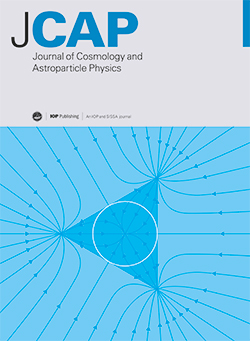塞弗特星系NGC 4151的伽马射线发射:超高速流出的多信使含义
IF 5.9
2区 物理与天体物理
Q1 ASTRONOMY & ASTROPHYSICS
Journal of Cosmology and Astroparticle Physics
Pub Date : 2025-07-03
DOI:10.1088/1475-7516/2025/07/013
引用次数: 0
摘要
塞弗特星系典型的核活动可以在高能现象发生的地方驱动强大的风。尽管它们的能量含量很高,但在伽马射线中检测到的这种非喷射活动星系核(AGN)的数量非常有限。Fermi-LAT望远镜最近发现的4FGL J1210.3+ 3928,在空间上与blazar 1E 1217.9+3945和NGC 4151是一致的,NGC 4151是一个位于15.8 Mpc的塞弗特星系,以其最内层核心的超高速流出物(ufo)而闻名。我们发现4FGL J1210.3+3928的局域化可能受到附近两个源叠加的波动的影响。我们探索了NGC 4151作为高能源的可能性,并得出结论,在UFO风终止激波处的粒子加速可以解释观测到的伽马射线通量的亮度和光谱形状,而1E 1217.9+3945的多波长光谱能量分布不利于它作为主要的GeV伽马射线对应物。有趣的是,NGC 4151在空间上也与冰立方中微子天文台发现的微弱中微子事件一致。我们计算了UFO对这种中微子过剩的贡献,并讨论了其他可能的发射区域,如AGN最近的邻居。本文章由计算机程序翻译,如有差异,请以英文原文为准。
Gamma-ray emission from the Seyfert galaxy NGC 4151: multi-messenger implications for ultra-fast outflows
The nuclear activity typical of Seyfert galaxies can drive powerful winds where high-energy phenomena occur. In spite of their high power content, the number of such non-jetted active galactic nuclei (AGN) detected in gamma rays is very limited. 4FGL J1210.3+ 3928, a source recently discovered by the Fermi-LAT telescope, is spatially consistent with the blazar 1E 1217.9+3945 and NGC 4151, a Seyfert galaxy located at about 15.8 Mpc known for hosting ultra-fast outflows (UFOs) in its innermost core. We show that the localization of 4FGL J1210.3+3928 might be affected by fluctuations due to a superposition of the two nearby sources. We explore the possibility of NGC 4151 to be a high-energy source and we conclude that particle acceleration at the UFO wind termination shock can explain the luminosity and spectral shape of the observed gamma-ray flux, whereas the multiwavelength spectral energy distribution of 1E 1217.9+3945 disfavors it as the dominant GeV gamma-ray counterpart. Interestingly, NGC 4151 is also spatially coincident with a weak excess of neutrino events identified by the IceCube neutrino observatory. We compute the contribution of the UFO to such a neutrino excess and we discuss other possible emission regions such as the AGN nearest neighborhood.
求助全文
通过发布文献求助,成功后即可免费获取论文全文。
去求助
来源期刊

Journal of Cosmology and Astroparticle Physics
地学天文-天文与天体物理
CiteScore
10.20
自引率
23.40%
发文量
632
审稿时长
1 months
期刊介绍:
Journal of Cosmology and Astroparticle Physics (JCAP) encompasses theoretical, observational and experimental areas as well as computation and simulation. The journal covers the latest developments in the theory of all fundamental interactions and their cosmological implications (e.g. M-theory and cosmology, brane cosmology). JCAP''s coverage also includes topics such as formation, dynamics and clustering of galaxies, pre-galactic star formation, x-ray astronomy, radio astronomy, gravitational lensing, active galactic nuclei, intergalactic and interstellar matter.
 求助内容:
求助内容: 应助结果提醒方式:
应助结果提醒方式:


